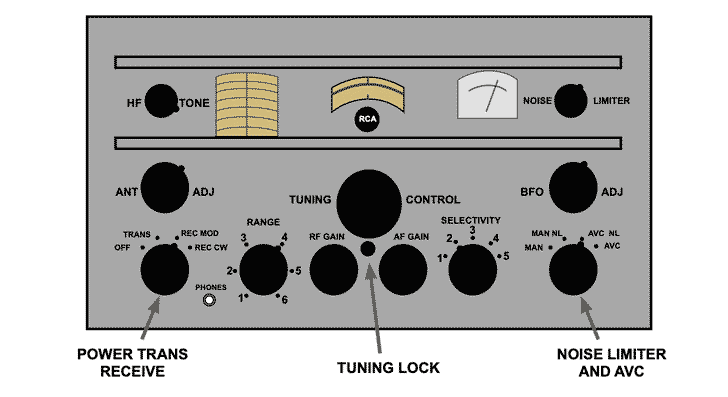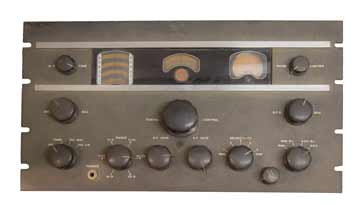RCA AR88 Radio Communications Receiver
The RCA AR88 was a radio receiver developed and manufactured in the 1940s for military communications and later surplus radios were used by radio amateurs.
RCA AR88 Radio Receiver Includes:
RCA AR88
AR88 circuit description & block diagram
Iconic radio receivers:
Summary of iconic radio receivers
Radio receiver history
Crystal radio sets
Development of the superhet radio
Radio history / timeline
The AR88 was an iconic radio communications receiver developed and manufactured by RCA, Radio Corporation of America in the early 1940s.
The receiver was widely used in Britain and Russia as part of the lend lease arrangement that was agreed between the UK and USA on the outbreak of World War II.The AR88 receiver provided high levels of performance for its day, and it was said that when it was designed, cost was not an object.

Today the AR88 receiver is known, not only for its performance and looks but also its weight - it weighed around 100 lbs and was definitely considered to be a two man lift.
There were two main variants of the AR88, namely the AR88D and the AR88LF. Not nearly as many were built as the AR88D and AR88LF, so these are the main types that are seen mentioned.
RCA AR88 variants and versions
With many successful developments, a number of variants are introduced to meet specific needs or to fit in with the numbering schemes of different organisations. The RCA AR88 is no exception and there are several variants and numbers used for the receiver.
| AR88 Variants and Numbers |
|
|---|---|
| AR88 Variant | Details |
| AR88 | This is the generic number for all the receivers. |
| AR88D | This was the most widely manufactured type of the AR88. It covered 0.54 to 32 Mc/s and had an IF of 455 kc/s. |
| AR88F | This version of the AR88 was intended for diversity reception. It is not commonly seen. |
| AR88LF | As the name indicates this version of the AR88 covered low frequencies. Coverage extended from 70 kc/s to 550kc/s and then from 1.5 Mc/s to 30 Mc/s. This variant was developed specifically to cover the frequencies below 540 kc/s that the "D" variant did not cover, but at the expense of reducing coverage of other frequencies. |
| CR88 | A post war version of the AR88 with a crystal phasing control on the front panel. It was used for both commercial and military applications. This series was easily identified by the light grey front panel. |
Development of the AR88
The AR88 development is thought to have started around 1939. It built on the previous receivers from RCA, in particular the AR60 which was showing its age, even though it was only introduced around 1935. This shows how fast radio technology was moving at the time.
The aim of the development was to provide a top class radio communications receiver where cost was no object. As such it utilised the latest technology along with high quality components, and a very solid mechanical structure.
The radio also had an electronic circuit design which was not limited by the number of valves used, the number of components incorporated or their quality.
Although the USA had not entered World War II at this stage, there was nevertheless an impetus to complete the electronic circuit design of the receiver and start production as soon as possible. This was because the AR88s were to be supplied to Britain to support her effort resisting the Nazi aggression.
As a result of their efforts, the design was completed in 1941 and the first shipments started that year.

The majority of the radios were manufactured at the RCA site in Camden, New Jersey, but additional facilities were brought on line in Bloomington, Indiana as well as in Montreal, Canada - in fact the later variant of the AR88, called the AR88LF was exclusively manufactured at the Canadian site.
The handbook for the AR88 states the manufacturing site as Camden N.J. USA.
Manufacture of the AR88D took place between 1941 and 1945, and it is estimated that a total of around 30000 of these receivers were manufactured.
Later the AR88 was further developed and a version called the CR88 was introduced in 1946. Other models were also introduced of which the CR88B was the last which was introduced in 1951.
Use of AR88 radio receiver
The majority of the production of the AR88 radios was sent to places such as Great Britain, Russia, and a few to France, and even China. They were also widely used for other allied receiving stations in North Africa and India.
In Great Britain the radios were used in many areas, but one of the most interesting was for what were termed "Y" stations which were monitoring the German encrypted radio communications.
The German signals were generally encrypted using the Enigma enciphering machine and the signals were generally thought to be impossible to break. However at Bletchley Park in England a large group of mathematicians, linguists and academics worked on these signals and were able to break a large proportion of them.
Other forms of signals, which were termed "Tunny" by Bletchley Park carried very high level radio communications messages. The encryption for these messages was also broken. Using the first computers, these messages were regularly decrypted and with such speed that it sometimes happened that the allied forces knew of the German intentions before the local German commanders.
Being able to receive these signals to decrypt was obviously a major element of the process. Y stations were set up all over the UK, as well as in other outlying parts of what was then the British Empire in areas such as India as well as North Africa.
For many of the receiving stations, the RCA AR88 was one of the main receivers used, and it was certainly one that had a very high level of performance. Accordingly huge numbers were used.
After the war, many of these receivers came onto the surplus market, and were picked up by many short wave listeners and radio amateurs (as they were called then).
AR88 specification
The specification for the AR88 generally follows the same pattern for both the AR88D and AR88LF although there are naturally some differences.
The major differences between the AR88D and AR88LF are defined in the summary below.
| Brief Specification for the RCA AR88 Radio Receiver |
|
|---|---|
| Parameter | Specification |
| Basic description | Single conversion superhet using 14 valves which provides general coverage reception for radio communications signals over a wide range of coverage. |
| Frequency Coverage | AR88D: 535 kc/s - 32 Mc/s AR88LF: 70 kc/s to 550kc/s & 1.5 Mc/s to 30 Mc/s |
| Bands (AR88D) | AR88D: AR88LF: |
| Intermediate frequency | AR88D: 455 kc/s AR88LF: 735 kc/s |
| Image rejection | This varied according to the frequencies, but soem figures are included from the manual: |
| Sensitivity | Signal for 20dB signal to noise ratio: at 1 Mc/s: 8µV at 8 Mc/s: 6.8µV at 28 Mc/s: 7µV |
| Reception modes | CW, MCW, & AM. (SSB could be received using the BFO, but it was not in widespread use until many years after the introduction of the receiver. |
| Audio output | 2.5 W into 2.25Ω or 600 Ω |
| LT consumption | 6.3 V at 4 A |
| HT consumption | 250 - 300 V at 90 mA |
| Mains input | 100 - 165 V or 190 - 260 V AC 50 - 60 c/s |
| Dimensions | 19¼ inches wide x 11 inches high x 19¼ inches deep |
| Weight | 100 lbs (45.3 kg) |
RCA AR88 circuit overview
The AR88 is a single conversion superhet radio communications receiver that follows a relatively straightforward topology.

he RF input block consists of two stages of RF amplification based around two 6SG7 valves or tubes. The stages are tuned to provide rejection of unwanted frequencies and this improves the image rejection and it prevents strong off-channel signals overloading.
The signals then enter the mixer stage using a 6AS7 where they are mixed with local oscillator signal to convert them down to the intermediate frequency of 455 kc/s.
The local oscillator is based around 6J5 and this provides a stable (for a free running oscillator) signal. The mechanical and coil arrangements were carefully designed to ensure the maximum stability.
The intermediate frequency follows a traditional format using three stages to provide te required gain. The valves used are three 6AS7s.
Selectivity is provided by the tuned interstage transformers and a crystal filter. There are several selectivity options that are available and these are arranged by changing the interstage coupling as well as switching the crystal filter in or out.
The detection is provided by a 6H6 diode valve and this feeds the audio stages. which consist of a preamplifier and final amplifier. The AR88 is know for its high quality audio when compared to other radio communications receivers.
Further circuit blocks include a beat frequency oscillator whose output is injected into the final IF stage. This provides the audio tone required for copying CW, and was later used for resolving single sideband.
A double diode noise limiter is also included to reduce the impact of static transients.
The receiver also incorporates an automatic gain control which operates on the RF and IF stages to level the gain of the receiver dependent upon the incoming signal level.
The RCA AR88 receiver was a classic receiver of its day. Introduced during World War II, it gave tremendous service when it was needed and formed the mainstay of many monitoring and . Later versions of the receiver were produced into the 1950s. After the war, fewer receivers were needed and also as newer technology was introduced they fell out of use in military and government circles. Many of the radios were destroyed, but also a very large number came onto the surplus market where they were snapped up by short wave listeners and radio amateurs (radio hams). The AR88 represented the pinnacle of radio performance of the day, and even now it is considered to be a classic radio communications receiver.
 Written by Ian Poole .
Written by Ian Poole .
Experienced electronics engineer and author.
More History:
Radio history timeline
History of the radio
Ham radio history
Coherer
Crystal radio
Magnetic detector
Spark transmitter
Morse telegraph
Valve / tube history
PN junction diode invention
Transistor
Integrated circuit
Quartz crystals
Classic radios
Mobile telecoms history
Vintage mobile phones
Return to History menu . . .


